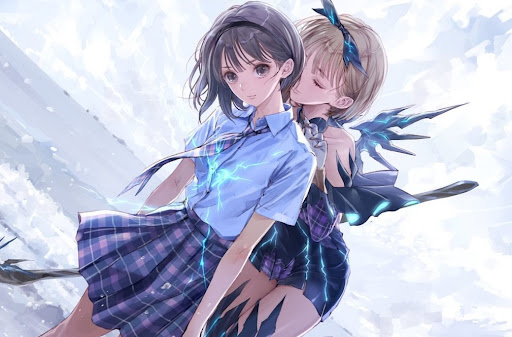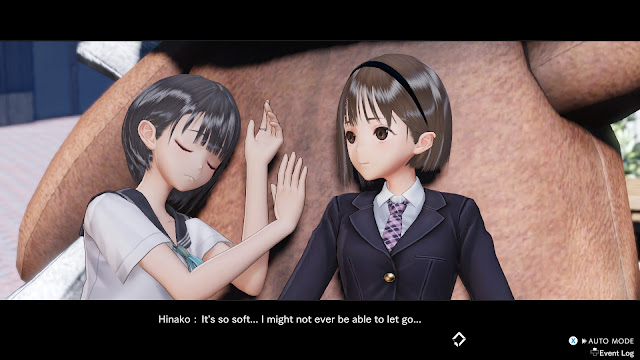Blue Reflection was such an unfortunately misunderstood game that I never thought we’d get a sequel. It told a heartfelt and wonderfully romantic story of coming of age and companionship between girls. Of acceptance and solidarity. Of dreams lost and social responsibility. Backed with character design by Mel Kishida, surely the artist with the sharpest eye for beauty going in the anime space, Blue Reflection was a distinctive, memorable, and emotionally evocative kind of game. It had a purity of vision that made it a rare bit of art indeed.
Unfortunately, it also had scenes that people chalked up as fan service, and as a consequence, the game developed a reputation for being something that it wasn’t. I’ve argued that Blue Reflection’s frequent use of bathing, communal showering, swimming and other such bodies immersed in water events speaks to a Japanese view on bathing that we don’t necessarily have in the west, and that lent the game an unfortunate and unintended tone on the western release (check out my feature on that in the Dee Dee Zine). Nonetheless, despite the unfortunate reputation, Mel Kishida and the team were given a second swing at the series, and Blue Reflection: Second Light delivers on every level. This thing is just so beautiful.
At its core, Second Light is the same as its predecessor: it is an often bittersweet and wholesome coming of age story for its large ensemble cast. This time around, though, it happens within the context of what can only be termed an “ethereal mystery”. See, each of the girls finds herself trapped in an otherwise deserted school that seems to exist on a different plane of existence to reality, surrounded by water, and she awakens in this world completely without her memories. By delving into special dungeons, she can remember key events and lessons that she learned in life, gain her memories back and (often) summon another girl that is important to her into the world. That girl is without her own memories, so the process starts anew. Meanwhile, as this happens, cracks appear in the sky, an “AI” application that they’re all forced to subscribe to claims to be a helper, but only deepens the mystery, and during idle moments the girls wonder about how they ended up on this island/school prison. Theories range from this space being a period of “waking up” after a long period of cryogenesis, or that they’re all dead and this is some kind of heaven.
Naturally I’m not going to tell you the answers here, but the overarching narrative moves at a good pace while keeping the revelations going. It’s also not the real focus of Blue Reflection: Second Light’s storytelling. Rather, the deepening relationships between the girls it’s what the story wants you to really focus on. Much like in a Persona game, the main protagonist, Ao, can take girls on dates, and by deepening the relationship with them, she can power up the team for the dungeon delves. That’s the mechanical value of doing so. The narrative value is far more simple: these are a great bunch of girls and you’re going to want them all to hook up. Just so they can be happy.
To be clear: Second Light is very yuri and makes no pretence otherwise. It’s overt even in comparison to Blue Reflection (which itself was really not trying to hide it). While there are no sex scenes, the flirting and depth of soul-bearing during the deep-and-meaningfuls between the girls make it clear that this magical girls story is less Sailor Moon than it is what if Sailor Moon gave Tuxedo Mask the flick and hooked up with Sailor Jupiter instead? (yes, please!). I’m no expert when it come to LGBT analysis, so bear that in mind, and for all I know the game has messed this up in some way, but what I did love about Second Light is that it really came across as being sweet and wholesome about it all. It was less a blunt and forced statement from a character to the effect of “I’m gay and now we kiss” as we’ve seen in a certain new release Marvel film, as it is simply a matter of these girls naturally developing deeper relationships with one another and, yep, eventually they start holding hands and talking tender to one other.
I found every character, their complexes, their journey in overcoming those challenges, and their eventual relationships with the other characters to be compelling. Blue Reflection: Second Light’s biggest flaw is that it is perhaps a little too sickly sweet at times, but it’s nice to have a JRPG this year that has been motivated by such overwhelming wholesome energy, when the same year has brought us the discourse on revolution (Tales of Arise), cyberpunk (Scarlet Nexus), existentialism and nihilism (NieR Replicant), and the concept of the self (The Caligula Effect). Those are all excellent games with some important things to muse on, but it’s nice to have something that is this warm. This ethereal. It’s a terribly difficult aesthetic and tone to try and hit in a way that doesn’t come across as silly, especially when you’re going to have people studying every word for a slip-up, but I love the generally warming and uplifting experience that writers at Gust has written here.
That’s why it absolutely sucks that this game is going to be wrapped up in the fan service discourse. On both sides. On the one hand, we’re going to have people that see school uniforms and optional swimsuits and read sexualization into a game that doesn’t have that. There’s romance, yes, but there’s absolutely none of the sexual airs in the game unless you’re manufacturing that from your own world view. We all know that Koei Tecmo’s creatives know how to turn the sex right up when they want to – Dead or Alive is undeniably full of sexualized energy. Project Zero: Maiden of Black Water, released just a week ago, goes out of its way to be sexy. Blue Reflection: Second Light isn’t that. It’s just not. Even when you dress the girls up in those swimsuits, they’re not sexy. It’s amusing and silly and, yes, fan service, but there’s a distinction there that I wish people would be better able to leap to.
Meanwhile, on the other hand, there are going to be people that are somehow convinced that this game is going to be “censored” because Gust blanks out efforts to upskirt the girls in the photo mode (which, for the record, would have been sexualization and that’s how Dead or Alive and Project Zero does it). Those people are, of course, missing the point that these games were never meant to be sexy. Beautiful, yes. Kawaii, even, to use an appropriate Japanese term. But not titillating. Not in the original, and not in this one. The fan service is still there and one of the bikinis, in particular, provides an eyeful, but, again, there’s a distinction at play in Second Light that I wish people were better aware of. The “fan service” conversation is just not one that should dominate the discourse about this game.
Putting all of that aside, Blue Reflection: Second Light is a triumph of art direction. Every location is absolutely beautiful. Every character gorgeous. The delicate, air-like music that plays in the background adds the ethereal resonance that makes the predominantly soft colours all the more warm to behold. Second Light appears to depict a kind of apocalyptic setting, but it is the anti-Fallout in that it’s colourful and painterly, rather than harsh on the eyes. That is to say, except for the occasional boss, which rival some of Final Fantasy’s finest for beastly overwroughtness. However, these creatures are disruptions to the otherwise natural order of beauty are like that for a reason, and it only makes those battles more memorable.
Speaking of combat, Blue Reflection: Second Light has a beautifully streamlined turn-based system that will be particularly comfortable for people that grew up with ATB systems in earlier Final Fantasy titles. It’s also strategic. At the start of a battle you can only fill up one “bar” of energy, but by attacking and using abilities you will unlock a second, and third bar of energy, which will give you access to higher-tier abilities and will, eventually, transform your characters into their souped-up magical girl version.
At the same time, you need to manage a combo meter. The more you build that up, the more damage you’ll do to opponents. However, some enemies (particularly bosses) have special attacks that can reduce the counter back to zero. If that happens, the boss battle can turn into a lengthy grind if not become outright impossible, so you’ll need to be ready to react with the appropriate counter when those big, combo-breaking are projected. Second Light doesn’t have the most complex battle system out there, but boss battles and optional side-battles can be testing and the elegance of the system means that it never breaks with the rhythm of the game, which is a great thing because, in those dungeons, enemy encounters can be avoided, but are going to be frequent anyway.
Outside of battle Second Light has a couple of things going for it, and most of them are good. Not only are there the aforementioned dates and character bonding sessions, but there’s a crafting system (don’t worry, those who are put off by Atelier, it’s nowhere near that complex). I’m not usually a fan of crafting systems (Atelier aside), but I loved this one because one of the major outcomes was having new little facilities to build around the school campus, ranging from tropical deck chairs to cafés, and these both boost your team’s abilities, and make for some awesome date locations once built.
The only thing I could not stand, at all, were the rare stealth sections. I have no idea what was going through the minds of the team at Gust when they added these, but crawling around and watching sight arcs from enemies as they patrol around adds nothing to the Blue Reflection experience whatsoever. They’re very infrequent, so they’re a chore that I can stomach through without having my opinion about the rest of the game affected in any way, but seriously, Gust, no. Unless you’re specifically designing a game around stealth, it’s not the mechanic to throw in for the sake of variety.
There’s not much else I can say about Blue Reflection: Second Light. I often say that the original Blue Reflection is the most beautiful game. I say that because while it obviously didn’t compare to the AAA-blockbusters in terms of the money that has been thrown at it, the art direction was so pitch-perfect and downright beautiful that the technical limitations were irrelevant. Second Light clearly had a bigger budget and made the most of that to present a more refined and confident take on the Blue Reflection vision. The story is a vibrant, the JRPG action is classical and engaging, and the aesthetics are pristine. Getting something this wholesome and pure is a rare treat in an industry obsessed with hard and serious storytelling and adult themes, and I strongly suspect that, just like the original Blue Reflection, I’m not going to be able to get Second Light out of my mind for years to come.
– Matt S.












